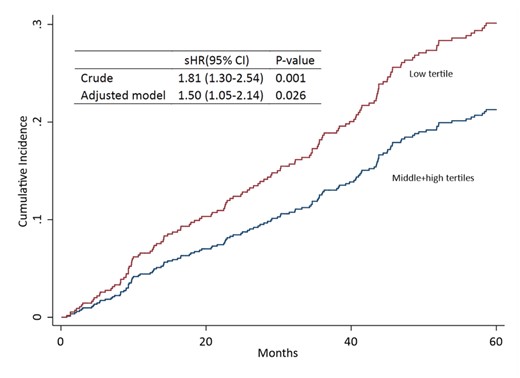-
PDF
- Split View
-
Views
-
Cite
Cite
Xin Li, Kristin Danielson, Innas Forsal, Ken Iseri, Lu Dai, Olof Heimbürger, Franz Peter Barany, Peter Stenvinkel, Abdul Rashid Tony Qureshi, Bengt Lindholm, P0673
INVERSE ASSOCIATION OF TRANSFERRIN SATURATION WITH MORTALITY RISK IN CHRONIC KIDNEY DISEASE, Nephrology Dialysis Transplantation, Volume 35, Issue Supplement_3, June 2020, gfaa142.P0673, https://doi.org/10.1093/ndt/gfaa142.P0673Close - Share Icon Share
Abstract
Transferrin saturation (TSAT) is an indicator of iron deficiency or overload, but its relationship with mortality in patients with different stages of chronic kidney disease (CKD) is unclear. We investigated the association of TSAT with mortality in CKD patients.
In 479 CKD patients (97 CKD3-4 patients, 298 CKD5 non-dialysis patients and 84 peritoneal dialysis patients; median age 58 years, 67% males, 33% cardiovascular disease, CVD, and 29% diabetes), biomarkers of iron status (plasma iron, TSAT, transferrin and ferritin), systemic inflammation (high sensitivity C-reactive protein, hsCRP, and interleukin-6, IL-6) and nutritional status were assessed. During median follow-up of 35.6 months, 139 (29%) patients died, and 176 (37%) patients underwent renal transplantation. Patients were stratified into low (n=157) and high (n=322) TSAT tertile groups. All-cause and CVD mortality risk were analyzed with competing risk regression with renal transplantation as competing risk.
TSAT [median 23% (IQR 17-30%)] was negatively associated with presence of DM and CVD, body mass index, hsCRP, IL-6, Framingham´s CVD risk score (FRS), erythropoietin resistance index (ERI) and iron supplementation, and positively associated with hemoglobin, ferritin and s-albumin. In competing risk analysis, low tertile of TSAT was independently associated with increased all-cause mortality risk (sHR=1.50, 95%CI 1.05-2.14) after adjusting for CKD stages, 1-SD of FRS, 1-SD of hemoglobin, 1-SD of hsCRP, 1-SD of ESA dose and iron supplementation (Figure 1).

Cumulative incidence curves of 5-years all-cause mortality in relation to tertiles of TSAT levels (n=479). Figure inset show sHR for association of Low vs. Middle and high tertiles of TSAT with mortality in crude and adjusted model.
TSAT was inversely associated with mortality risk in CKD patients. When evaluating clinical outcomes of CKD patients, iron status using TSAT as a predictive marker, should be considered.
- hemodialysis
- peritoneal dialysis
- iron
- body mass index procedure
- cardiovascular diseases
- diabetes mellitus
- renal transplantation
- inflammation
- albumins
- kidney failure, chronic
- diabetes mellitus, type 2
- hemoglobin
- biological markers
- follow-up
- plasma
- rats, inbred shr
- risk assessment
- transferrin
- c-reactive protein
- dialysis procedure
- ferritin
- interleukin-6
- mortality
- nutritional status
- treatment outcome
- iron deficiency
- transferrin saturation measurement
- predictive marker
- erythropoietin resistance





Comments